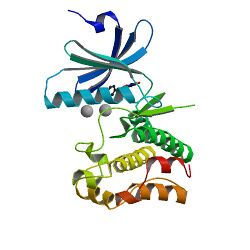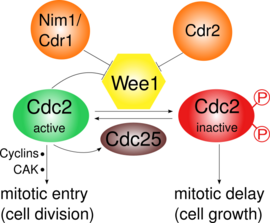Wee1
Topic: Biology
 From HandWiki - Reading time: 8 min
From HandWiki - Reading time: 8 min
| Wee1 | |
|---|---|
 Crystal structure of human Wee1 | |
| Identifiers | |
| Symbol | Mitosis inhibitor protein kinase Wee1 |
| Alt. symbols | wee1 dual specificity protein kinase Wee1 |
| NCBI gene | 2539123 |
| UniProt | P07527 |
| Other data | |
| EC number | 2.7.11.1 |
Wee1 is a nuclear kinase belonging to the Ser/Thr family of protein kinases in the fission yeast Schizosaccharomyces pombe (S. pombe). Wee1 has a molecular mass of 96 kDa and is a key regulator of cell cycle progression. It influences cell size by inhibiting the entry into mitosis, through inhibiting Cdk1. Wee1 has homologues in many other organisms, including mammals.
Introduction
The regulation of cell size is critical to ensure functionality of a cell. Besides environmental factors such as nutrients, growth factors and functional load, cell size is also controlled by a cellular cell size checkpoint.
Wee1 is a component of this checkpoint. It is a kinase determining the timepoint of entry into mitosis, thus influencing the size of the daughter cells. Loss of Wee1 function will produce smaller than normal daughter cell, because cell division occurs prematurely.
Its name is derived from the Scottish dialect word wee, meaning small - its discoverer Paul Nurse was working at the University of Edinburgh in Scotland at the time of discovery.[1][2]
Function
Wee1 inhibits Cdk1 by phosphorylating it on two different sites, Tyr15 and Thr14.[3] Cdk1 is crucial for the cyclin-dependent passage of the various cell cycle checkpoints. At least three checkpoints exist for which the inhibition of Cdk1 by Wee1 is important:
- G2/M checkpoint: Wee1 phosphorylates the amino acids Tyr15 and Thr14 of Cdk1, which keeps the kinase activity of Cdk1 low and prevents entry into mitosis; in S. pombe further cell growth can occur. Wee1 mediated inactivation of Cdk1 has been shown to be ultrasensitive as a result of substrate competition.[4] During mitotic entry the activity of Wee1 is decreased by several regulators and thus Cdk1 activity is increased. In S. pombe, Pom1, a protein kinase, localizes to the cell poles. This activates a pathway in which Cdr2 inhibits Wee1 through Cdr1. Cdk1 itself negatively regulates Wee1 by phosphorylation, which leads to a positive feedback loop. The decreased Wee1 activity alone is not sufficient for mitotic entry: Synthesis of cyclins and an activating phosphorylation by a Cdk activating kinase (CAK) are also required.[5]
- Cell size checkpoint: There is evidence for the existence of a cell size checkpoint, which prevents small cells from entering mitosis. Wee1 plays a role in this checkpoint by coordinating cell size and cell cycle progression.[6]
- DNA damage checkpoint: This checkpoint also controls the G2/M transition. In S. pombe this checkpoint delays the mitosis entry of cells with DNA damage (for example induced by gamma radiation). The lengthening of the G2 phase depends on Wee1; wee1 mutants have no prolonged G2 phase after gamma irradiation.[7]
Epigenetic function of Wee1 kinase has also been reported. Wee1 was shown to phosphorylate histone H2B at tyrosine 37 residue which regulated global expression of histones.[8] [9]
Homologues
| human WEE1 homolog (S. pombe) | |
|---|---|
| Identifiers | |
| Symbol | WEE1 |
| NCBI gene | 7465 |
| HGNC | 12761 |
| OMIM | 193525 |
| RefSeq | NM_003390 |
| UniProt | P30291 |
| Other data | |
| Locus | Chr. 11 p15.3-15.1 |
| human WEE1 homolog 2 (S. pombe) | |
|---|---|
| Identifiers | |
| Symbol | WEE2 |
| NCBI gene | 494551 |
| HGNC | 19684 |
| RefSeq | NM_001105558 |
| UniProt | P0C1S8 |
| Other data | |
| Locus | Chr. 7 q32-q32 |
The WEE1 gene has two known homologues in humans, WEE1 (also known as WEE1A) and WEE2 (WEE1B). The corresponding proteins are Wee1-like protein kinase and Wee1-like protein kinase 2 which act on the human Cdk1 homologue Cdk1.
The homologue to Wee1 in budding yeast Saccharomyces cerevisiae is called Swe1.
Regulation
In S. pombe, Wee1 is phosphorylated
Cdk1 and cyclin B make up the maturation promoting factor (MPF) which promotes the entry into mitosis. It is inactivated by phosphorylation through Wee1 and activated by the phosphatase Cdc25C. Cdc25C in turn is activated by Polo kinase and inactivated by Chk1.[6] Thus in S. pombe Wee1 regulation is mainly under the control of phosphorylation through the polarity kinase, Pom1's, pathway including Cdr2 and Cdr1.[10][11][12][13]
At the G2/M transition, Cdk1 is activated by Cdc25 through dephosphorylation of Tyr15. At the same time, Wee1 is inactivated through phosphorylation at its C-terminal catalytic domain by Nim1/Cdr1.[12] Also, the active MPF will promote its own activity by activating Cdc25 and inactivating Wee1, creating a positive feedback loop, though this is not yet understood in detail.[6]
Higher eukaryotes regulate Wee1 via phosphorylation and degradation
In higher eukaryotes, Wee1 inactivation occurs both by phosphorylation and degradation.[14]
The protein complex[nb 1] SCFβ-TrCP1/2 is an E3 ubiquitin ligase that functions in Wee1A ubiquitination. The M-phase kinases Polo-like kinase (Plk1) and Cdc2 phosphorylate two serine residues in Wee1A which are recognized by SCFβ-TrCP1/2.[15]
S. cerevisiae homologue Swe1
In S. cerevisiae, cyclin-dependent kinase Cdc28 (Cdk1 homologue) is phosphorylated by Swe1 (Wee1 homologue) and dephosphorylated by Mih1 (Cdc25 homologue). Nim1/Cdr1 homologue in S. cerevisiae, Hsl1, together with its related kinases Gin4 and Kcc4 localize Swe1 to the bud-neck. Bud-neck associating kinases Cla4 and Cdc5 (polo kinase homologue) phosphorylate Swe1 at different stages of the cell cycle. Swe1 is also phosphorylated by Clb2-Cdc28 which serves as a recognition for further phosphorylation by Cdc5.
The S. cerevisiae protein Swe1 is also regulated by degradation. Swe1 is hyperphosphorylated by Clb2-Cdc28 and Cdc5 which may be a signal for ubiquitination and degradation by SCF E3 ubiquitin ligase complex as in higher eukaryotes.[16]
Role in cancer
The mitosis promoting factor MPF also regulates DNA-damage induced apoptosis. Negative regulation of MPF by WEE1 causes aberrant mitosis and thus resistance to DNA-damage induced apoptosis. Kruppel-like factor 2 (KLF2) negatively regulates human WEE1, thus increasing sensitivity to DNA-damage induced apoptosis in cancer cells.[17]
Mutant phenotype
Wee1 acts as a dosage-dependent inhibitor of mitosis.[18] Thus, the amount of Wee1 protein correlates with the size of the cells:
The fission yeast mutant wee1, also called wee1−, divides at a significantly smaller cell size than wildtype cells. Since Wee1 inhibits entry into mitosis, its absence will lead to division at a premature stage and sub-normal cell size. Conversely, when Wee1 expression is increased, mitosis is delayed and cells grow to a large size before dividing.
See also
Notes
- ↑ β-transducin repeat-containing protein 1/2 (β-TrCP1/2) F-box protein-containing SKP1/Cul1/F-box protein complex
References
- ↑ Nurse P (December 2004). "Wee beasties". Nature 432 (7017): 557. doi:10.1038/432557a. PMID 15577889. Bibcode: 2004Natur.432..557N.
- ↑ "Regulatory genes controlling mitosis in the fission yeast Schizosaccharomyces pombe". Genetics 96 (3): 627–37. November 1980. doi:10.1093/genetics/96.3.627. PMID 7262540. PMC 1214365. http://www.genetics.org/cgi/pmidlookup?view=long&pmid=7262540.
- ↑ "The Wee1 protein kinase regulates T14 phosphorylation of fission yeast Cdc2". Mol Biol Cell 6 (4): 371–85. 1995. doi:10.1091/mbc.6.4.371. PMID 7626804.
- ↑ Kim, SY; Ferrell JE, Jr (23 March 2007). "Substrate competition as a source of ultrasensitivity in the inactivation of Wee1.". Cell 128 (6): 1133–45. doi:10.1016/j.cell.2007.01.039. PMID 17382882.
- ↑ "Cdc2 regulatory factors". Current Opinion in Cell Biology 6 (6): 877–82. 1994. doi:10.1016/0955-0674(94)90060-4. PMID 7880537.
- ↑ 6.0 6.1 6.2 Kellogg DR (2003). "Wee1-dependent mechanisms required for coordination of cell growth and cell division". J Cell Sci 116 (24): 4883–90. doi:10.1242/jcs.00908. PMID 14625382.
- ↑ "The wee1 protein kinase is required for radiation-induced mitotic delay". Nature 356 (6367): 353–5. 1992. doi:10.1038/356353a0. PMID 1549179. Bibcode: 1992Natur.356..353R.
- ↑ "H2B Tyr37 phosphorylation suppresses expression of replication-dependent core histone genes.". Nature Structural & Molecular Biology 19 (9): 930–7. 2012. doi:10.1038/nsmb.2356. PMID 22885324.
- ↑ "WEE1 tyrosine kinase, a novel epigenetic modifier.". Trends Genet. 29 (7): 394–402. 2013. doi:10.1016/j.tig.2013.02.003. PMID 23537585.
- ↑ "Replication checkpoint enforced by kinases Cds1 and Chk1". Science 280 (5365): 909–12. May 1998. doi:10.1126/science.280.5365.909. PMID 9572736. Bibcode: 1998Sci...280..909B.
- ↑ "Nim1 kinase promotes mitosis by inactivating Wee1 tyrosine kinase". Nature 363 (6431): 738–41. June 1993. doi:10.1038/363738a0. PMID 8515818. Bibcode: 1993Natur.363..738W.
- ↑ 12.0 12.1 "Negative regulation of the wee1 protein kinase by direct action of the nim1/cdr1 mitotic inducer". Cell 72 (6): 919–29. March 1993. doi:10.1016/0092-8674(93)90580-J. PMID 7681363.
- ↑ "Two distinct mechanisms for negative regulation of the Wee1 protein kinase". EMBO J. 12 (9): 3427–36. September 1993. doi:10.1002/j.1460-2075.1993.tb06017.x. PMID 7504624.
- ↑ "Regulation of the human WEE1Hu CDK tyrosine 15-kinase during the cell cycle". EMBO J. 14 (9): 1878–91. May 1995. doi:10.1002/j.1460-2075.1995.tb07180.x. PMID 7743995.
- ↑ Watanabe N; Arai H; Nishihara Y et al. (March 2004). "M-phase kinases induce phospho-dependent ubiquitination of somatic Wee1 by SCFbeta-TrCP". Proc. Natl. Acad. Sci. U.S.A. 101 (13): 4419–24. doi:10.1073/pnas.0307700101. PMID 15070733. Bibcode: 2004PNAS..101.4419W.
- ↑ "Monitoring the cell cycle by multi-kinase-dependent regulation of Swe1/Wee1 in budding yeast". Cell Cycle 4 (10): 1346–9. October 2005. doi:10.4161/cc.4.10.2049. PMID 16123596. http://www.landesbioscience.com/journals/cc/abstract.php?id=2049.
- ↑ Wang F; Zhu Y; Huang Y et al. (June 2005). "Transcriptional repression of WEE1 by Kruppel-like factor 2 is involved in DNA damage-induced apoptosis". Oncogene 24 (24): 3875–85. doi:10.1038/sj.onc.1208546. PMID 15735666.
- ↑ "Negative regulation of mitosis by wee1+, a gene encoding a protein kinase homolog". Cell 49 (4): 559–67. May 1987. doi:10.1016/0092-8674(87)90458-2. PMID 3032459.
External links
 |
 KSF
KSF
